Experience the Flavors of South Africa: Authentic Trinchado Recipe
Embark on a culinary journey to South Africa with our exquisite Trinchado recipe. This classic South African-Portuguese beef stew is a true delight, featuring tender cubes of steak enveloped in a rich, subtly spicy sauce. Slow-cooked to perfection with robust red wine and savory beef stock, the stew is infused with aromatic red chili, fragrant garlic, and earthy bay leaves.
While some Trinchado recipes opt for a leaner profile, our version embraces the addition of cream. This transforms the sauce into a velvety masterpiece, adding a luxurious richness that beautifully complements the gentle warmth of the chili, creating a perfectly balanced and deeply satisfying dish.
What Our Readers Say
“I’ve been searching for years to perfect my Trinchado, and this recipe is truly superb! It was an absolute hit with my family last night. Highly recommend!”
– Günter
⭐⭐⭐⭐⭐
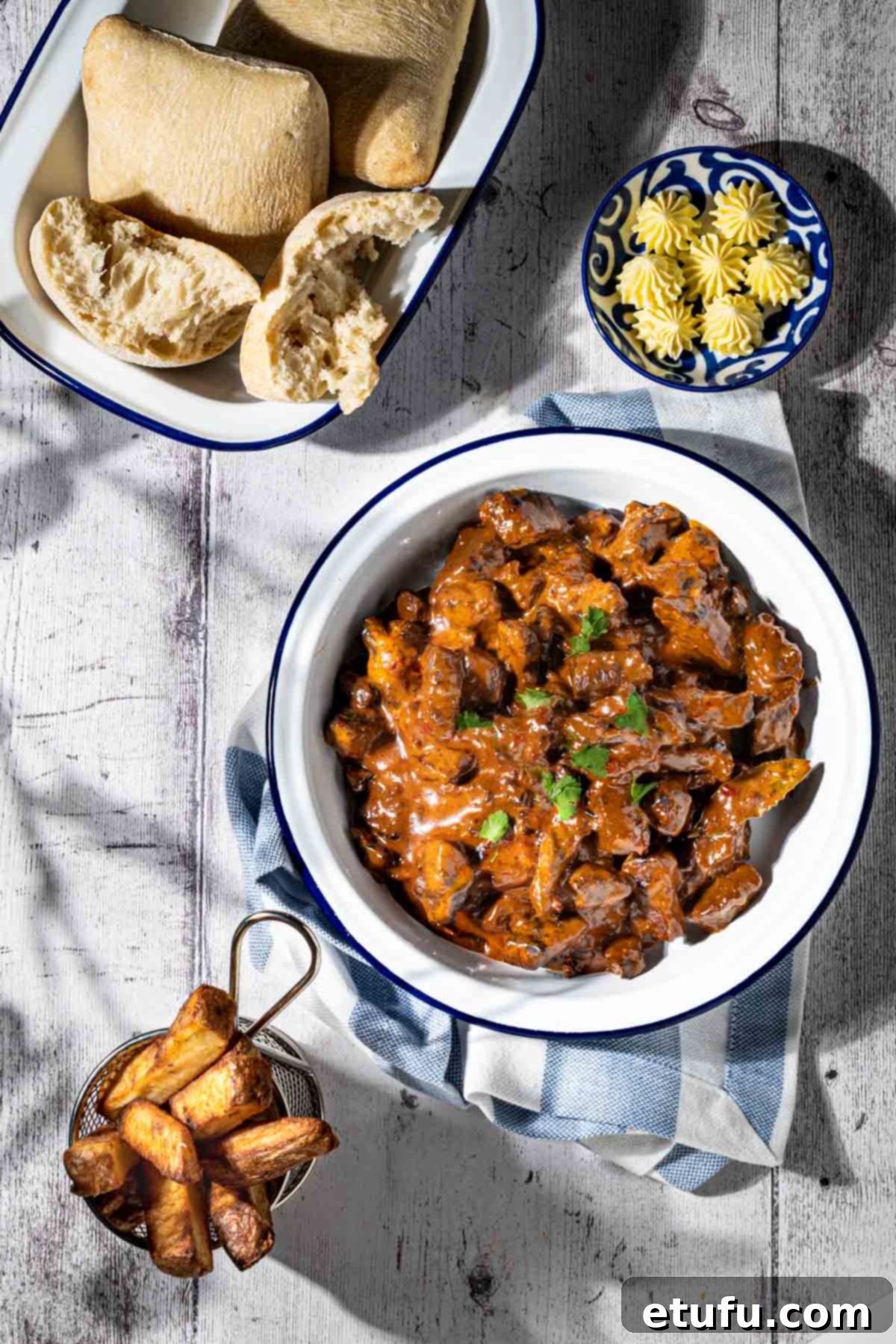
South Africa: A Taste of the Nation
South Africa is a country brimming with diverse cultures, breathtaking landscapes, and an incredibly rich culinary heritage. Located at the southernmost tip of the African continent, it’s a melting pot of influences, from indigenous traditions to European and Asian flavors, all contributing to its unique character. Trinchado, with its Portuguese roots adapted into the vibrant South African food scene, perfectly encapsulates this fusion.

| Location | Southernmost tip of the African continent, bordered by Namibia, Botswana, Zimbabwe, Mozambique, Eswatini (formerly Swaziland), and Lesotho. Its stunning coastline stretches over 2,500 kilometers along the Atlantic and Indian Oceans. |
| Languages | South Africa boasts 11 official languages, reflecting its diverse population: English, Afrikaans, Zulu, Xhosa, Sotho, Tswana, Pedi, Venda, Tsonga, Swati, and Ndebele. English is widely understood and used in business, while Zulu and Xhosa are the most commonly spoken African languages, each carrying deep cultural significance. |
| Population | Approximately 60.2 million people call South Africa home, contributing to a vibrant mix of cultures, traditions, and culinary styles. |
| Fascinating Trivia: The Sardine Run | One of nature’s most spectacular events, the Sardine Run, occurs annually along South Africa’s east coast. Billions of sardines migrate northwards, creating massive shoals that can stretch up to seven kilometers long, 1.5 kilometers wide, and 30 meters deep – so vast they are visible from space! This incredible phenomenon attracts a feeding frenzy of predators, including dolphins, sharks, seals, whales, and countless seabirds, offering an unparalleled wildlife spectacle. |
Why You’ll Adore This Beef Trinchado Recipe
Our Trinchado recipe is more than just a meal; it’s an experience designed for ease, comfort, and unforgettable flavor. Here’s why it will quickly become a household favorite:
- **Effortless & Exquisite:** This is an easy-to-follow recipe that delivers perfectly balanced, complex flavors without requiring advanced culinary skills. It’s perfect for both novice cooks and seasoned chefs.
- **The Ultimate Comfort Food:** With its rich, hearty beef and warming spices, Trinchado is the quintessential comfort food. It’s particularly appealing to those who prefer savory meat dishes, often satisfying even the most discerning palates.
- **Time-Efficient:** Unlike many traditional stews that demand hours of cooking, our Trinchado recipe offers a relatively shorter cooking time, making it an excellent choice for a weeknight meal or when you need a flavorful dish in less time.
- **Deep, Flavorful Sauce:** The sauce is the star of this dish – deep, rich, and infused with a delightful spicy kick. Its thick consistency is ideal for soaking up with crusty bread or crispy chips, embodying its strong Portuguese culinary heritage.
- **Versatile Serving Options:** Enjoy Trinchado as a robust main course, or serve it in smaller portions as an appetizer, perfect for sharing and sparking conversation at any gathering.
Essential Ingredients: Notes & Savvy Substitutions
Crafting the perfect Trinchado begins with understanding your ingredients. Below, we’ve detailed key components and offered helpful tips for substitutions to ensure your dish is nothing short of spectacular.
**For the complete list of ingredients with precise quantities, please refer to the comprehensive recipe card located at the bottom of this article.

Cubed Beef: The Heart of the Stew
For this recipe, we recommend using rump steak for its excellent flavor and texture when slow-cooked. However, you have several fantastic alternatives. Porterhouse, sirloin, or rib-eye steaks will also yield delicious results. If you’re aiming for ultimate tenderness and a truly luxurious experience, fillet steak is an exceptional choice, budget permitting. If you prefer a different red meat, lamb rump can be an equally delightful substitute, offering a slightly different but equally rich flavor profile.
Pro Tip for UK Shoppers: Keep an eye out for Aldi’s ‘Big Daddy Extra Thick Rump Steak‘ – it’s often a fantastic, affordable option. Two of these steaks typically weigh just under a kilo, but we’ve tested it, and the original recipe quantities for all other ingredients still work perfectly, ensuring a robust and flavorful sauce.
A Special Note on Dry-Aged Meat
We received valuable feedback from a reader, Conrad, who experimented with dry-aged rump for his Trinchado. This insightful experience led us to an important consensus: when using dry-aged meat, you should significantly reduce the cooking time.
Dry-aged beef has already undergone a process of moisture loss, which intensifies its flavor and tenderizes the meat. Therefore, to prevent it from becoming overcooked or dry in the stew, we recommend reducing the simmer time by approximately one-third. Aim for no more than an hour of cooking, rather than the standard one and a half hours, to ensure your dry-aged Trinchado remains succulent and flavorful.
Worcestershire Sauce: The Flavor Booster
Simply use your favorite plain old Worcestershire sauce. Its unique savory, tangy, and slightly sweet profile is crucial for marinating the beef and adding depth to the final sauce, creating a foundational layer of flavor.
Vegetable Oil: The Searing Agent
Any neutral-flavored oil will work beautifully here. Olive oil is an excellent choice for its subtle fruitiness, but sunflower oil or corn oil are equally effective for searing the meat and sautéing the aromatics without overpowering the other flavors.
Onions: The Aromatic Base
Whether you choose red, brown, or white onions, their finely chopped presence forms the aromatic foundation of the Trinchado. They caramelize slightly during cooking, adding a subtle sweetness and depth to the sauce.
Red Chillies: The Gentle Kick
This recipe calls for two fresh red chillies. The key is to adjust the quantity based on your personal heat preference and, crucially, the specific type of chilli you are using. In the UK, common supermarket red chillies are generally milder, often resembling a Serrano variety, providing a pleasant, gentle simmer rather than an aggressive burn. Bird’s eye chillies, for instance, are considerably hotter, so exercise caution and adjust accordingly. For those who crave extra heat, a small pinch of cayenne pepper can be added alongside the fresh chillies.
Garlic: The Soul of Trinchado
We often opt for the convenient route of pre-minced or chopped garlic from tubes or tubs, which saves time without sacrificing flavor. However, if you prefer the unparalleled pungency of fresh garlic, the recipe suggests using approximately 5-6 large cloves. While this might seem like a generous amount, the substantial garlic presence is absolutely vital to developing the characteristic, robust flavor profile of Trinchado.
Flour: The Thickening Agent
Plain flour is used to thicken the sauce, giving it a rich, luxurious consistency. Alternatively, cornflour can be used. To prevent clumping, always create a slurry by mixing one tablespoon of cornflour with approximately two tablespoons of cold water before adding it to the simmering sauce.
Beef Stock: The Liquid Foundation
For convenience, quality beef stock cubes are perfectly acceptable. We typically use two Oxo beef stock cubes dissolved in 300ml of water. Since stock cubes often contain salt, remember to taste the stew before adding any extra salt later in the cooking process.
Red Wine: The Depth of Flavor
While purists might advocate for Portuguese red wine, it’s not strictly necessary. Any dry red wine you enjoy drinking will work wonderfully. We often lean towards a Malbec to maintain a Latin theme, but most red wines will contribute the necessary acidity and fruit notes to the rich sauce.
Cream: The Silky Finish
The addition of cream is non-negotiable in this version of Trinchado; it truly makes a remarkable difference to the body and texture of the dish. The recipe calls for 150ml of double cream, but feel free to adjust the quantity based on your desired sauciness and the liquid level in your pot. The goal is to add *some* cream for that signature silky richness.
Optional Enhancements for Your Trinchado
While our core Trinchado recipe is exceptional on its own, these optional additions can introduce intriguing new dimensions to the flavor profile, allowing you to customize the dish to your preference:
Optional Acidity: For a refreshing lift and brightness that cuts through the richness, consider adding a touch of lemon zest, a dash of fresh lemon juice, or a splash of balsamic vinegar. While not traditional, these acidic elements can elevate the overall flavor experience.
Optional Peri-Peri Sauce: Some enthusiasts enjoy a bolder, more fiery kick. If this describes you, incorporate a few splashes (approximately two tablespoons) of Peri-Peri sauce into the stew along with the other liquid ingredients. This adds a distinctive South African-Portuguese chili heat.
Optional Olives: For a briny, savory depth, black olives are a fantastic addition. Stir in about 20 pitted black olives when you return the browned beef to the saucepan. They will meld beautifully with the sauce as it simmers.
Trinchado Versus Traditional Stew: A Culinary Distinction
It’s important to approach Trinchado not as your typical, everyday stew, but as a distinct culinary creation with its own unique characteristics:
- **Ingredient Focus:** Traditional stews often utilize more budget-friendly ingredients, such as tougher cuts of meat that benefit from long, slow cooking, and a generous inclusion of vegetables like potatoes and carrots, making them a more economical meal.
- **Flavor Profile:** Traditional stews tend to have a milder, more rustic flavor, often relying on herbs and foundational vegetables for their taste. Trinchado, in contrast, boasts a concentrated, rich, and often spicier sauce, with the meat being the undeniable star.
- **Economic Considerations:** Because Trinchado primarily focuses on meat in a decadent sauce, it tends to be less economical per portion than a typical vegetable-laden stew.
- **Serving Philosophy:** However, due to its intense richness and flavor, you’ll find that smaller portions of Trinchado are incredibly satisfying. It’s best enjoyed by generously bulking it out with fresh, crusty bread or chunky chips, which are perfect for soaking up every precious drop of the flavorful sauce. In our opinion, Trinchado is a luxurious, gourmet dish, designed to be savored and truly enjoyed.
Achieving Perfect Trinchado: Cooking Vessel & Consistency Notes
The success of your Trinchado largely depends on mindful cooking and managing liquid levels. The size and material of your pot or pan, along with the heat of your stove burner, will directly influence how quickly the liquid in your stew evaporates.
- **Pot Size Matters:** Avoid using a pot with an overly large surface area. A wider pot increases the rate of evaporation, which can cause the Trinchado to cook dry or even burn, preventing the development of that rich, luscious sauce.
- **Low and Slow is Key:** Once you begin the 1.5-hour simmering process, it is crucial to cook the Trinchado over the **lowest possible heat setting**. Ensure that the size of your gas ring or electric burner closely matches the diameter of the pot you are using for even heating.
- **Vigilant Monitoring:** Keep a close watch on your stew throughout the cooking time. Check the liquid level every 10-15 minutes and give it a gentle stir. If the Trinchado appears to be drying out, add a small splash of red wine or water to maintain consistency. Remember, you’ll be adding cream later, so don’t overdo it with extra liquid. Always scrape the bottom of the pot to prevent any sticking or burning.
- **Managing Excess Liquid:** Conversely, if there appears to be too much liquid, simply tilt the lid slightly to one side for a few minutes. This small gap will allow some steam to escape, helping the sauce to reduce and thicken to the desired consistency.
How to Make Trinchado: A Step-by-Step Guide
- **Prepare the Beef:** Begin by using a sharp knife to cut your chosen steak (rump, porterhouse, sirloin, rib-eye, or fillet) into large, bite-sized cubes. Aim for uniformity to ensure even cooking.

- **Marinate the Meat:** In a spacious bowl, combine the cubed beef with four tablespoons of Worcestershire sauce. Stir thoroughly to ensure every piece of meat is evenly coated with the rich, tangy marinade.
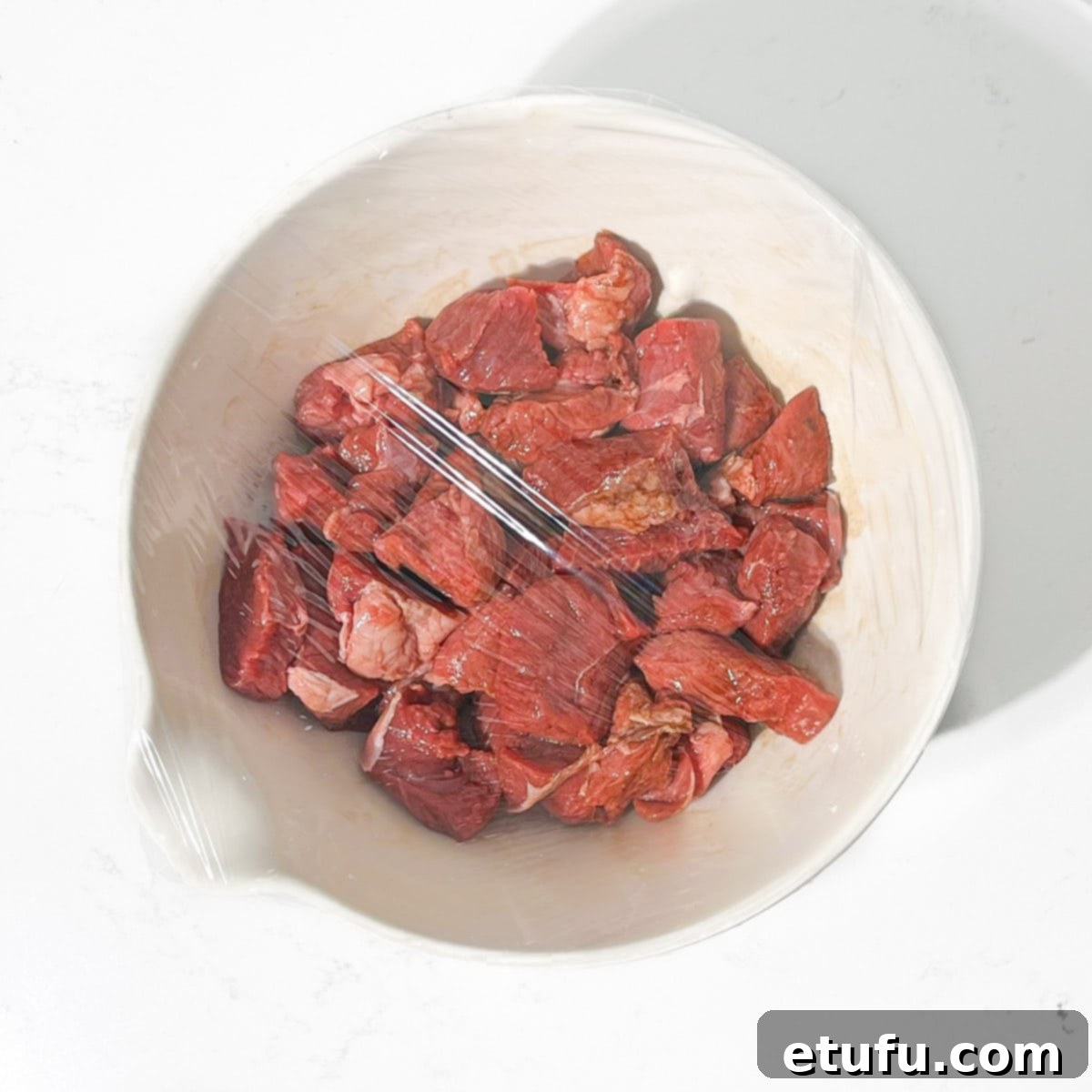
- **Chill and Infuse:** Cover the bowl tightly with plastic wrap and place it in the refrigerator for at least **30 minutes**. This marination time allows the beef to absorb the flavors, making it more tender and delicious.

- **Prepare the Liquid Base:** In a jug or a separate mixing bowl, combine the beef stock, red wine, a heaped tablespoon of tomato paste, and two teaspoons of sugar. Stir until well combined, creating the flavorful liquid for your stew.
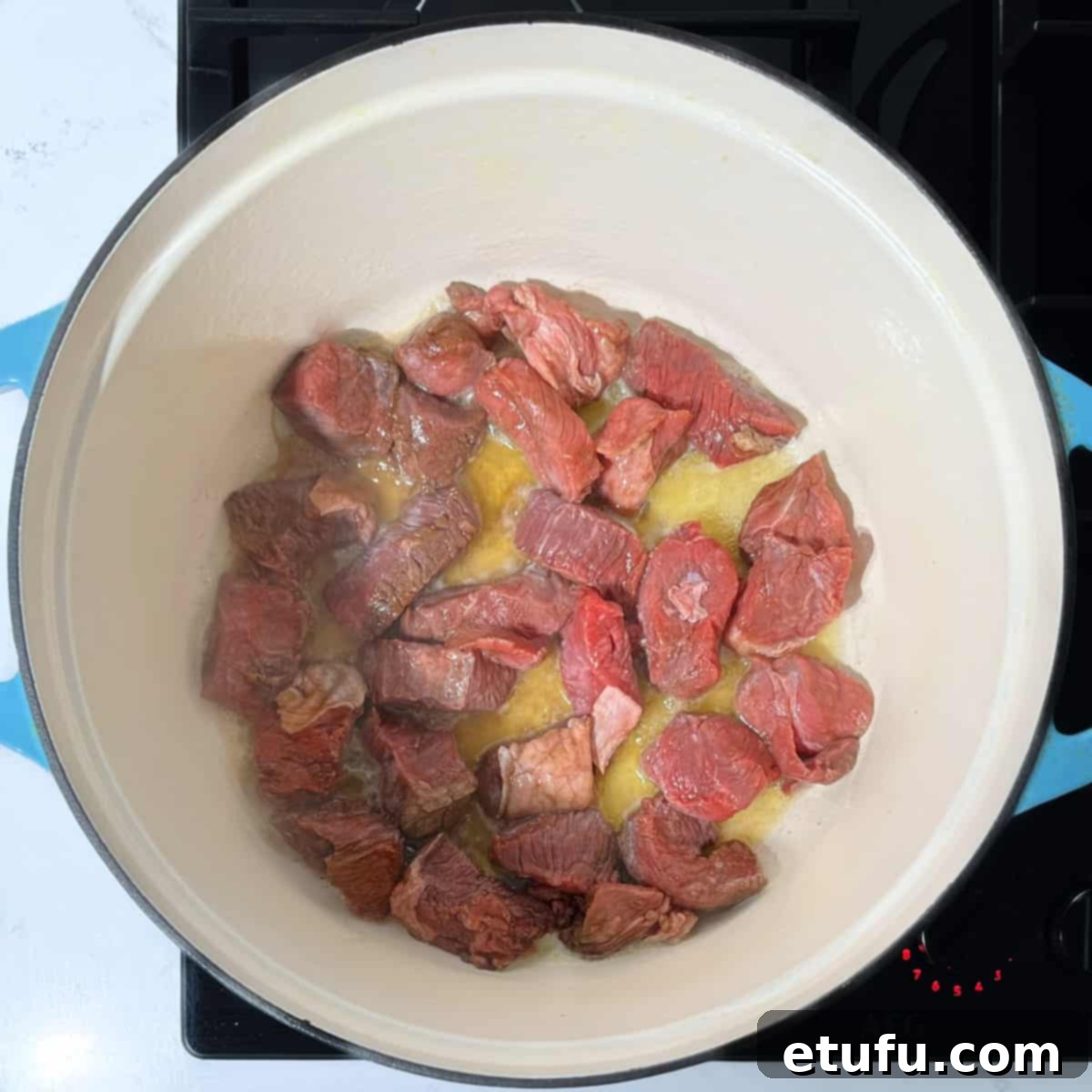
- **Sear the Beef:** Heat half of the butter (15g) and half of the vegetable oil (1 tbsp) in a medium-large, heavy-based saucepan over **medium-high heat**. Once the butter and oil are sizzling, carefully add the marinated beef in batches, ensuring not to overcrowd the pan. Fry until each cube is beautifully golden brown on all sides. This crucial step develops deep, caramelized flavors that are essential to the Trinchado.

- **Rest the Beef:** Using a slotted spoon, transfer the browned beef to the same bowl it was marinated in. Set aside for now.
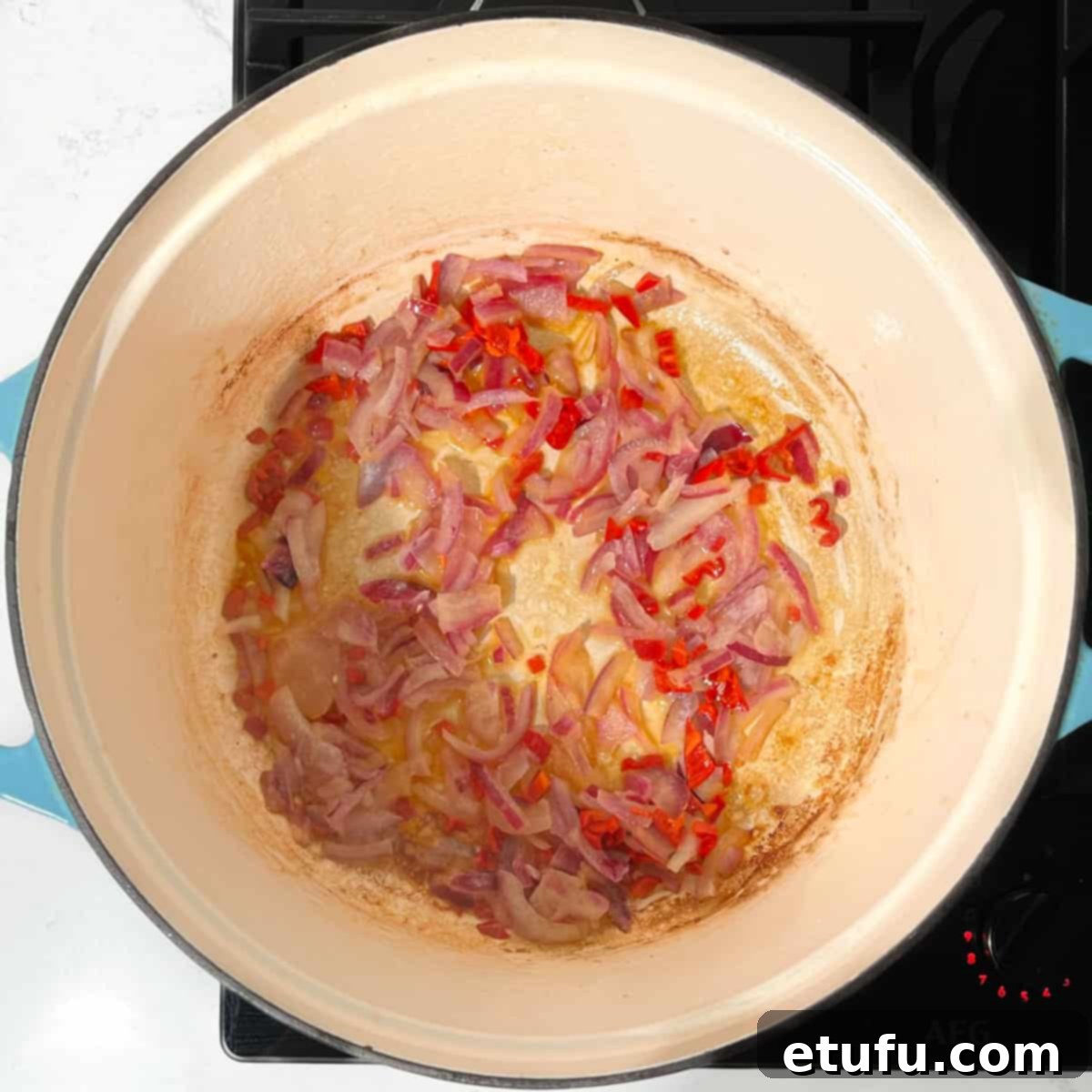
- **Sauté Aromatics:** Reduce the heat to medium. Add the remaining butter (15g) and oil (1 tbsp) to the saucepan. Once hot, add the finely chopped onions and red chillies. Sauté, stirring occasionally, for about **5 minutes**, until the onions become soft and translucent without browning too much.

- **Add Garlic:** Stir in the chopped garlic and cook for just **30 seconds** until fragrant. Be careful not to burn it.
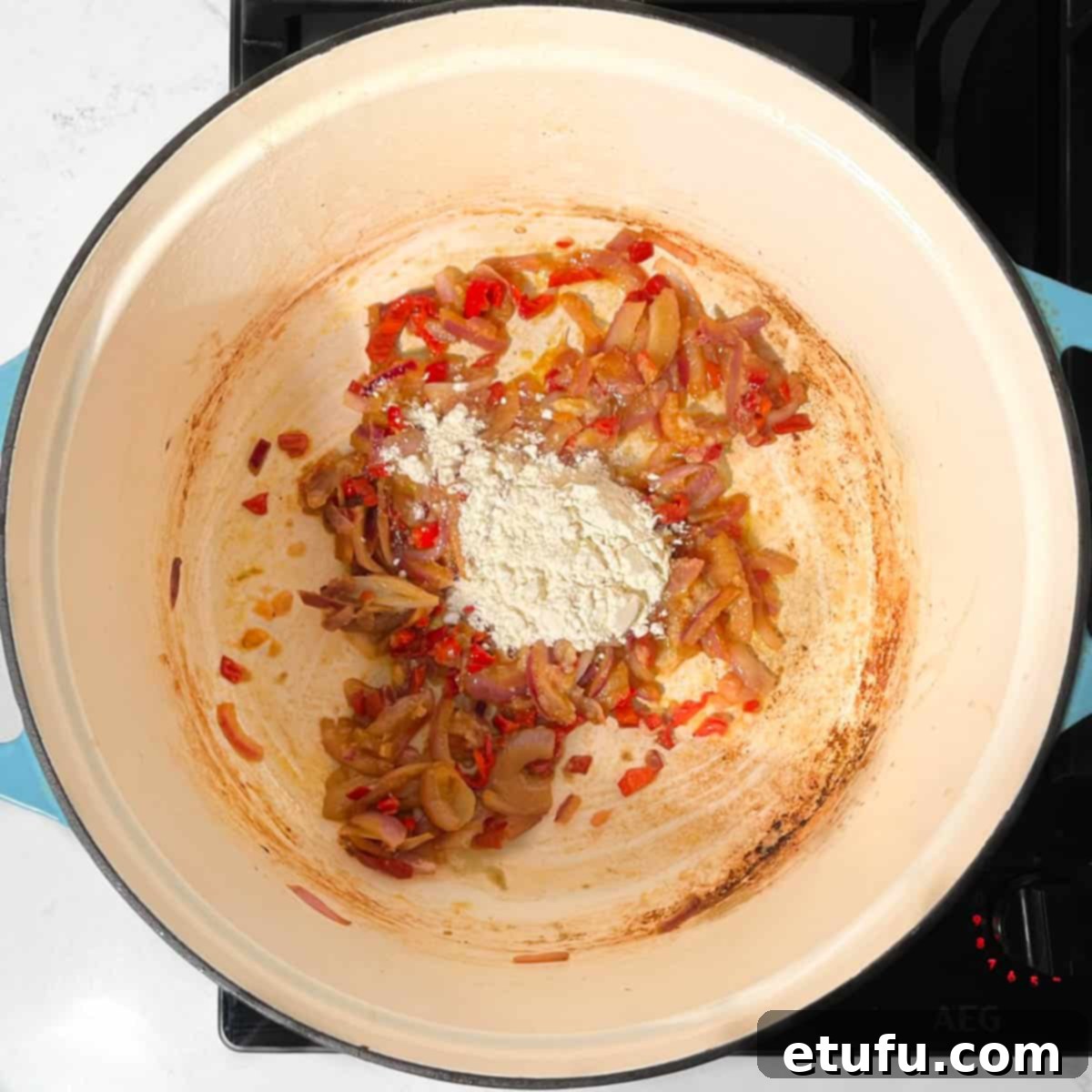
- **Incorporate Flour:** Sprinkle in the plain flour and stir it continuously through the onions and chillies for **1 minute**. Keep scraping the bottom of the pan to prevent excessive sticking. A little sticking is natural, but don’t worry, we’ll deglaze it shortly.
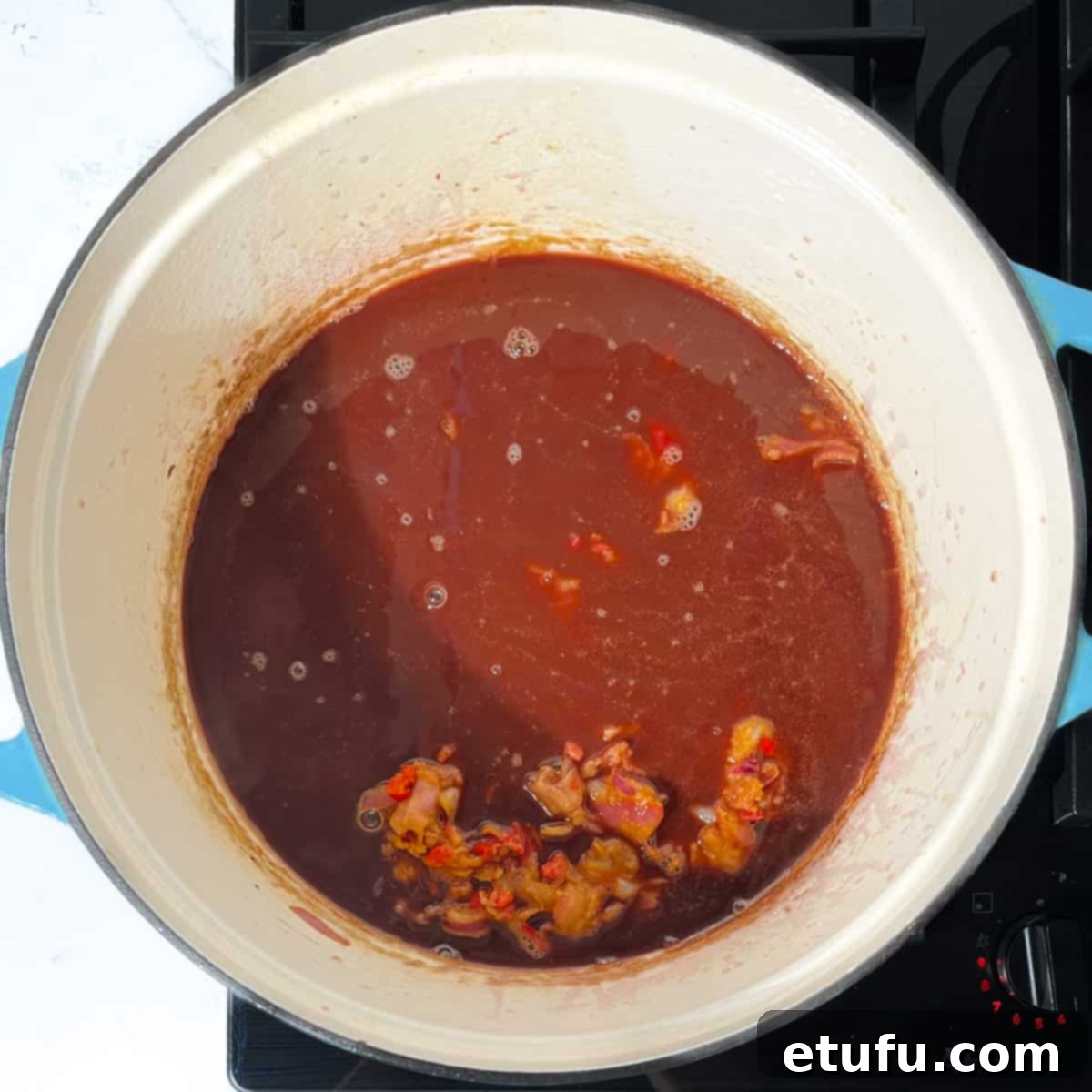
- **Deglaze and Simmer:** Pour the prepared liquid base into the saucepan. Immediately deglaze the pan by stirring and scraping up all the flavorful, sticky bits from the bottom. These fond particles will dissolve into the sauce, adding incredible depth. Reduce the heat to **low** and simmer the sauce for **2-3 minutes** until it begins to thicken slightly.
- **Add Bay Leaves:** Stir in the bay leaves.

- **Return Beef and Simmer:** Carefully add the browned beef back into the pan, along with any remaining marinade in the bowl. Stir the meat through the sauce, bring it to a gentle simmer, then cover the pan tightly with a lid. Continue to simmer on **low heat** for **1.5 hours**. Remember to check the liquid level and stir every **10-15 minutes**, adding a splash of red wine or water if the stew appears to be drying out.
- **Season to Taste:** After simmering, taste the Trinchado for seasoning. Add salt as needed, keeping in mind that your beef stock may already contribute a good amount of sodium. A half teaspoon is often sufficient.
- **Add Pepper:** Season generously with a few good grinds of fresh black pepper.

- **Finish with Cream:** Stir in the cream and heat through for **1-2 minutes**. At this point, you can adjust the sauciness further: if you desire more sauce, add a touch more cream; if it’s already perfect, use slightly less than the stated amount.
- **Rest Before Serving:** Allow the Trinchado to rest off the heat for **10 minutes** before serving. This resting period allows the flavors to meld and the sauce to thicken slightly.
- **Serve and Enjoy:** Serve your delicious Trinchado hot with chunky chips or fresh white bread rolls, perfect for soaking up every last drop of the incredible sauce.
Perfect Pairings & Serving Suggestions for Trinchado
Trinchado’s rich, savory flavors make it incredibly versatile. Here are some ideal accompaniments to elevate your dining experience:
- **Classic Chips (French Fries):** The traditional pairing! Serve chunky chips either on the side, nestled beneath the meat, or generously scattered on top. Their crispy texture and salty flavor are perfect for scooping up the luscious sauce.
- **Artisan Breads:** A must-have for soaking up every drop of that exquisite sauce. Any good, crusty bread will do, but for an authentic experience, seek out fresh Portuguese rolls (Papo Secos).
- **Parmentier Potatoes:** For a slightly more sophisticated side, roasted mini potatoes like Parmentier potatoes offer a delightful texture and absorb the sauce beautifully.
- **Fresh Herbs:** A sprinkle of freshly chopped parsley or coriander not only adds a pop of vibrant color but also a burst of refreshing flavor, balancing the richness of the stew.
- **Sour Cream Dollop:** For an extra layer of creamy coolness and a tangy contrast, offer a dollop of sour cream on the side.
- **Top Tip – Delicious Cold:** Believe it or not, Trinchado is surprisingly and wonderfully delicious served cold the next day! (Perhaps it’s just us, but we highly recommend trying it!)
Storage & Reheating Guidelines
Proper storage ensures you can enjoy your Trinchado for days to come:
Refrigeration: Trinchado keeps exceptionally well in an airtight container in the refrigerator for up to three days. When ready to reheat, you can use a microwave or gently warm it over low heat in a saucepan. If the sauce has thickened too much, add a splash of water or a touch more cream to loosen it to your desired consistency.
Freezing: This dish freezes beautifully for up to three months. To defrost, simply transfer it to the refrigerator the day before you plan to serve it. Reheat using the same methods as above: in the microwave or slowly in a saucepan, adding a little water or cream if needed to restore its texture.
Frequently Asked Questions (FAQ) About Trinchado
Trinchado is believed to have its origins in Angola and Mozambique, both of which were former Portuguese colonies. As vibrant Portuguese communities established themselves in South Africa, particularly in urban centers, they brought their culinary traditions with them. Trinchado became a popular dish sold in their cafes and restaurants, eventually being adopted and beloved as a staple in broader South African cuisine. Today, it’s a firm favorite and a common sight on many restaurant menus across the country.
The word ‘Trinchado’ is Portuguese and directly translates to ‘cut up meat’ or ‘sliced meat’, aptly describing the preparation of the beef in this delicious stew.
It is pronounced “Trin-cha-doh.”
For those eager to explore more traditional South African recipes, don’t miss our easy Bobotie, a flavorful baked mince dish, perfectly paired with fragrant basmati yellow rice. Conclude your meal with iconic South African desserts like the creamy milk tart, comforting malva pudding, or the delightful peppermint crisp tart – all national institutions.
If your cravings lean towards authentic Portuguese flavors, our Prego steak rolls and the legendary Nando’s spicy rice are absolute must-tries!
And for an elegant touch when serving bread with your Trinchado, discover how to make beautiful butter rosettes, just like the ones featured in our main photo.
Delicious Dishes That Pair Well With Trinchado
- Crispy Crumbed Mushrooms
- Fresh Bread Rolls (e.g., Danish Rundstykker)
- Parmentier Potatoes
- Spicy Masala Chips (Kenyan Style)
- Easy Fried Courgettes (Zucchini)
More Spicy Dishes You Might Enjoy
- Curry Noodle Salad (Kerrie Noedelslaai)
- Chilli Cheese Toast
- Quick Chicken Karahi
- The Very Best Devilled Sausages
Authentic Creamy Beef Trinchado Recipe

Beef Trinchado – Portuguese-Inspired South African Stew
Trinchado is a delectable Portuguese-inspired South African beef stew crafted from succulent cubed steak, simmered in a rich, spicy, and creamy sauce. Its origins are often traced back to neighboring Angola and Mozambique, former Portuguese colonies, before being embraced and perfected within South African culinary traditions.
Course: Appetizer, Main Course
Cuisine: Portuguese, South African
Prep Time: 20 minutes
Cook Time: 1 hour 30 minutes
Total Time: 1 hour 50 minutes
Servings: 4 servings (approx. 250g per person)
Calories: 738 kcal
Author: Maretha Corbett
Equipment
- 1 medium-large, lidded, heavy-based saucepan, or a cast iron pot/pan
Ingredients
- 1 kilogram rump steak (sliced into large cubes. Porterhouse, rib-eye, sirloin or fillet steak also work well)
- 4 Tablespoons Worcestershire sauce
- 300 millilitre prepared beef stock (e.g., 2 x Oxo beef cubes in 300ml water)
- 300 millilitre red wine
- 1 heaped tablespoon tomato paste
- 2 teaspoons sugar
- 30 grams butter
- 2 tablespoons vegetable oil
- 150 grams onion (red, white or brown onions, finely chopped)
- 2 red chillies (finely chopped. Adjust quantity based on taste and chilli type)
- 4 teaspoons garlic paste (or 5-6 fresh, minced large cloves)
- 2 tablespoons plain flour
- 3 bay leaves
- Salt to taste (use sparingly as beef stock is already salty)
- Few good grinds of black pepper
- 150 millilitre cream (double cream recommended)
Instructions
Prep the meat
- Use a sharp knife to cut the steak into large, bite-sized chunks.
- In a large bowl, combine the cubed meat with the Worcestershire sauce. Ensure every cube is coated by stirring the sauce through the meat.
- Cover the bowl with plastic wrap and let it sit in the fridge for at least 30 minutes to marinate.
Prep the liquid sauce
- Make the sauce by adding the beef stock, red wine, tomato paste and sugar to a jug or mixing bowl. Stir well to combine.
To make the Trinchado
- In a medium-large, heavy-based pan, heat half the butter (15g) and half the oil (1 tbsp) over medium-high heat. Once sizzling, batch-fry the cubed steak until browned on all sides. This is an important step as it adds flavour.
- Set the browned beef aside in the same bowl it was marinated in.
- Turn the heat down to medium. Add the remaining butter (15g) and oil (1 tbsp). Once hot, add the chopped onions and chillies. Fry until the onions are soft and translucent (about 5 minutes), stirring occasionally to prevent sticking.
- Add the garlic and fry for 30 seconds until fragrant.
- Add the flour and stir it through the onions. Cook for 1 minute, scraping the bottom of the pan to prevent flour from sticking too much (a little sticking is normal and will be deglazed).
- Add the sauce you combined earlier. Deglaze the pan by stirring and scraping any sticky bits from the bottom. Turn the heat down to low and simmer the sauce for 2-3 minutes until it starts to thicken slightly.
- Add the bay leaves to the sauce.
- Tip the browned meat into the pan along with any remaining liquid in the bowl. Stir the meat through the sauce and bring to a gentle simmer. Cover the pan tightly with a lid. With the heat still on low, simmer for 1.5 hours. Check the liquid level every 10-15 minutes and give it a quick stir. If it seems dry, add another splash of red wine or water.
- Taste for salt and add more if needed. Remember that beef stock is often salty.
- Add a few good grinds of black pepper.
- Add the cream. Stir and heat through for 1-2 minutes. Adjust cream quantity based on desired sauciness.
- Allow the Trinchado to rest for 10 minutes before serving.
- Serve with chunky chips or fresh white bread rolls to mop up the delicious sauce.
Notes
The type and size of the pot or pan you use, along with the gas ring/burner size on your stove, will significantly influence how quickly the Trinchado may lose liquid.
- Avoid using a pot with too large a surface area, as it can cause the liquid to evaporate too rapidly, which may cause the Trinchado to cook dry or burn.
- Cook over the lowest heat setting once you start the clock for the 1.5 hours, matching the gas ring/burner size to the pot you are using.
- Keep a constant eye on it. If it appears dry, add a small splash of wine or water, stirring it in (remember, you’ll be adding cream later too). Scrape the bottom to ensure it’s not sticking.
- If there seems to be too much liquid, shift the lid to the side for a few minutes to create a gap, allowing some steam to escape.
**Nutritional Data Disclaimer**
Please be aware that the nutritional information provided below is calculated by a third party, and we cannot guarantee its absolute accuracy. We strive to offer the most precise information possible but do not take responsibility for potential errors. Furthermore, the nutritional value of this recipe may vary depending on the exact brands and products used. We highly recommend consulting with a qualified healthcare professional or registered dietitian for personalized advice regarding your dietary needs.
Nutrition (per serving)
Calories: 738 kcal |
Carbohydrates: 20g |
Protein: 60g |
Fat: 39g |
Saturated Fat: 18g |
Polyunsaturated Fat: 5g |
Monounsaturated Fat: 12g |
Trans Fat: 0.3g |
Cholesterol: 214mg |
Sodium: 613mg |
Potassium: 1459mg |
Fiber: 1g |
Sugar: 9g |
Vitamin A: 1039IU |
Vitamin C: 40mg |
Calcium: 128mg |
Iron: 7mg
Explore More Iconic South African Recipes
Delve deeper into the rich tapestry of South African cuisine with these beloved dishes:
- Pikkie’s Melkkos (Milk Food)
- Bunny Chow
- Curry Noodle Salad
- Bobotie
- Yellow Rice (perfect with Bobotie)
- Peppermint Crisp Tart
- Rock Shandy (Refreshing Drink)
- Bar-One Sauce (Chocolate Sauce)
- Prego Steak Rolls
- Vetkoek (Fried Dough Bread)
- Hertzoggies (Jam and Coconut Tartlets)
- Curried Mince (filling for Vetkoek)
- Traditional South African Pancakes (Pannekoek)
For comprehensive food safety advice, including detailed guidance on managing food allergies, please refer to official guidelines.
More Convenient One-Pot & One-Pan Recipes
If you appreciate the simplicity and robust flavors of a one-pot meal like Trinchado, you’ll love these other easy-to-make dishes:
- Creamy Butter Bean Curry with Coconut Milk
- Easy Mince and Dumplings
- Authentic Nepalese Chicken Curry
- Easy Oven-Baked Chicken Pasanda Curry
- Rich Beef Curry with Coconut Milk
- Flavorful Chicken and Chorizo Jambalaya
